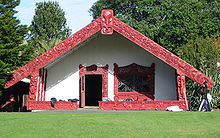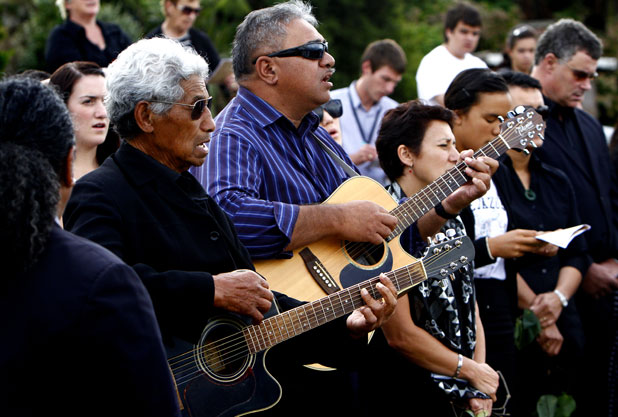The Maori in New Zealand honor those who have died with a three-day burial rite, which is becoming less commonly practiced these days, called the Tangihanga or the Tangi. The process is held at a communal and sacred place known as a marae. During the Tangi, the tribe never leaves the side of a member who has just lost a loved one. The coffins of those who have passed on are left either open on the porch at the marae, or inside the sacred place. The surviving loved ones constantly surround the coffin, ensuring that their beloved family member is never left alone.
“The surviving loved ones constantly surround the coffin, ensuring that their beloved family member is never left alone.”
The open coffin also allows for people to place flowers, photographs and any other means they have of communicating their love inside the final resting place of their loved one. This could be anything from stories, to jokes, to songs (or to simply let oneself cry). During the sharing of those who are grieving, the recently passed are instructed by those at the ceremony to return “home” to a mythological place where their ancestors come from: Hawaiki. The proposed method of travel for their spirit it through an underworld called “te rerenga wairua.”
“The proposed method of travel for their spirit it through an underworld…”
While those not related to the person who has died come to visit and communicate to them, it is customary for the family members to say nothing. After the burial rite of communicating is completed, the Maori use water to cleanse their hands and heads before they leave. The water ritual closely resembles similar rituals in Christianity; indeed, both religions believe water symbolizes cleansing and purification.
The vigil and time selection for the closing of lost loved ones’ coffins happen on the final night of the Tangi. The Maori then proceed with the more formal (and often religious) burial service. Water, again, plays a major role for those present once they leave the burial grounds. As a final celebration of the lost loved ones, the Maori people gather for a feast with gifts of food provided by non-family mourners. The tribe then performs a final act of cleansing as they use prayers and songs to aid the spirit of lost loved one in their departing from their former homes, as well as the location of their death.
“Water, again, plays a major role for those present…”
The tight bond between the tribe and lost loved ones does not cease after the Tangi because it is quite common for members to stay and look after the widows or widowers for several days. In this culture of New Zealand, it is reassuring to know that your friends and family will always look after your lost loved ones, surviving family members and you.
Related SevenPonds articles:

 Traditional Burial Rites for the Maori
Traditional Burial Rites for the Maori





 “Making Mobiles” by Karolina Merska
“Making Mobiles” by Karolina Merska
 “Hands Up to the Sky” by Michael Franti & Spearhead
“Hands Up to the Sky” by Michael Franti & Spearhead
 Coping With Election Grief
Coping With Election Grief















Hi there, I have a question, if I am not maori at all are my grandparents (who have no maori blood at all allowed to be burried on the marae?? Because my grandparents lived a long time helping and serving the maori community in Kaiangaroa Forest. When they passed away we were asked to have a Tangi and burry them in the graveyard my grandfather built on the marae. Is this allowed? If so does that make us apart of that Iwi?? If we were to go down and see them, do we need permission or notify anyone? We know nothing. We had friends help us during the funeral so we could respect the culture etc. Just wanting to feel the sense of belonging and learn if we are like “adopted” into the culture???
Report this comment
If you dont have any ties to the Marae, whanau/family – You request would of been denied outright. Outsiders are refused.
Report this comment
I am a very ignorant American. I am old, but not so wise. I know this must be a stupid question, but here it is. 50 years ago I saw some Hollywood movie (from California) where in the movie which was suppose to be in the South Pacific somewhere, taking place in the 1920’s or so. In the movie a person dies and the family and friends stand at the South Pacific edge and push a single one person canoe into the water with a dead person inside – a “funeral’ of sorts, I guess. And then when it was a short but not long distance from the shore, a bowman shot a flaming arrow into the canoe and set it on fire, and there was celebration for the spirit of the dead person. DO YOU KNOW OF ANY FUNERAL CELEBRATION BY ANY PEOPLES IN THE SOUTH PACIFIC THAT IS ANYTHING LIKE THIS??????? VERY CURIOUS since I had a friend who lived in the South Pacific area and has recently died.
Thank you for you help.
Report this comment
As far as I’m aware, the flaming arrows for burial on the water are from the Viking culture only. It is used in movies because it is such powerful imagery (burning water).
Report this comment
Have you seen the movie “First Knight” Same tradition of sending the person out into the water and shooting a arrow with fire to the deceased person to set them on fire.
Report this comment
I have a question with respects to the types of floral arrangements and flowers used for a typical sympathy piece. Are flowers sent to the family of the deceased? What kind of arrangements are at the service and/or burial site? What types of flowers are most common for a sympathy arrangement?
Thanks!
Report this comment
A Query, we lost a loved family memeber 5days ago and today we had a Kereru land in our Kowhai tree, he stayed for about an hour and seemed so calm as well he was feeding off the young sweet fauna, Does this point to any message or meaning for us of the loss of our brother?
Report this comment